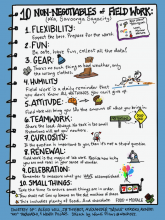What Are They Doing?
 Akmaliighaq (least auklets) at sunset. Kitnkik, east of Savoonga, St. Lawrence Island, Alaska. Photo by Lisa Sheffield Guy.
Akmaliighaq (least auklets) at sunset. Kitnkik, east of Savoonga, St. Lawrence Island, Alaska. Photo by Lisa Sheffield Guy.
Seabirds are considered to be ecosystem sentinels; their productivity and populations rely on availability of zooplankton and forage fish species. Long-term data suggest that conditions seabirds experience during the non-breeding season might have a large impact on their reproductive output and survival.
This project will help us understand the non-breeding ecology of seabirds. This need is especially pressing in areas of the Arctic undergoing changes in winter sea ice dynamics and increases in natural resource development. Using the data they collect, the team will develop a conceptual model of how warming in the Pacific Arctic will alter the region’s food web structure which is important for seabird conservation and management.
Where Are They?
 Vijay Patil does the last bird count of the evening. Savoonga, St. Lawrence Island, Alaska. Photo by Lisa Sheffield Guy.
Vijay Patil does the last bird count of the evening. Savoonga, St. Lawrence Island, Alaska. Photo by Lisa Sheffield Guy.
The team will base operations out of Savoonga, Alaska and visit sites that are 5 km, 18 km and 30 km from the village. The remote village is located on St. Lawrence Island in the Bering Sea.
Latest Journals

Alexis Will is a post-doctoral research fellow at the National Institute of Polar Research in Japan, and a research scientist at the Institute of Arctic Biology, University of Alaska Fairbanks. She works with an international team of researchers studying how seabirds respond to changes in their environment. Currently they are exploring how seabirds breeding in the Northern Bering Sea interact with sea ice during the non-breeding period to understand how changes in sea ice extent may impact seabird distributions in the future.
Research Interests:
The main focus of my current research program is on the fundamental question: Can we predict population responses (range shift, adaptation or extinction) to an environmental change based on current phenotypic and biological age structures of natural populations of marine top-predators?
Specifically, I am interested in (A) how climate- and human induced environmental changes affect physiology, reproduction and survival of different phenotypes in wild seabird populations; and (B) the consequences of such differential selection pressure on individuals for the spatial and temporal dynamics of their populations.





